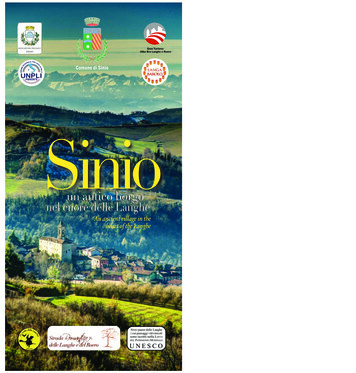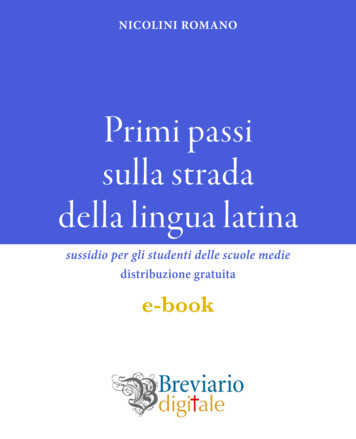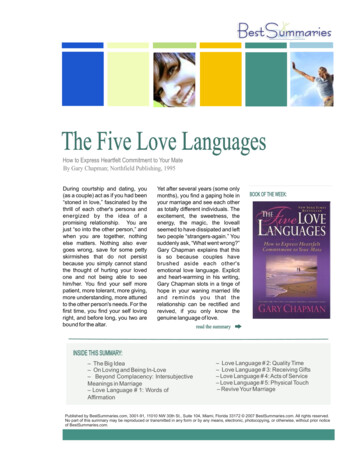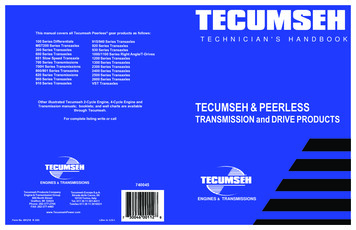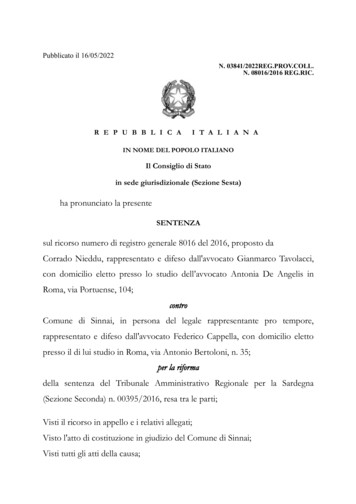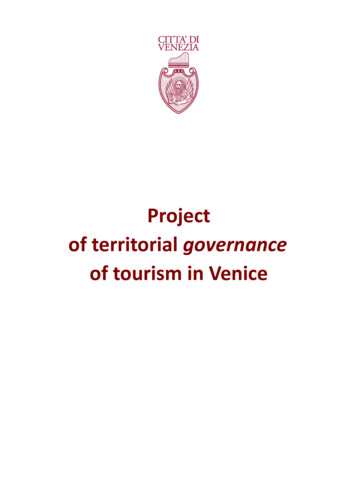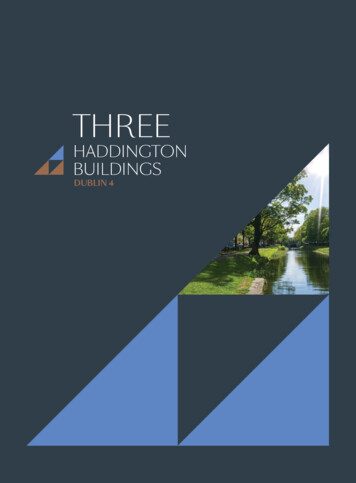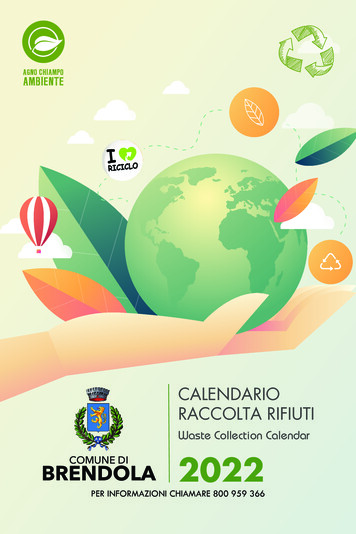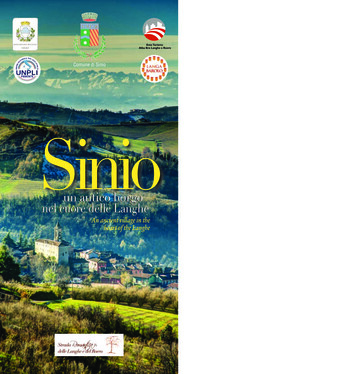
Transcription
Comune di SinioSinioun antico borgonel cuore delle LangheAn ancient village in theheart of the Langhe
Sinioe il suo territorioPartendo da Alba e risalendo il percorso del torrente Talloria, nel cuoredella valle si raggiunge Sinio, l’antico «Sineum». Èun luogo oggi principalmente rurale e turistico.Risale all’epoca medievale, ma con riferimenti storici ancor più antichi nellalocalità Reale. La denominazione del paese ha duepossibili interpretazioni.Una è di carattere morfologico (dal termine latinosinus), come rivela ancheil suo stemma originario:quale notevole seno delcorso del torrente in corrispondenza della collinasu cui è situato il concentrico; un’altra prevalente di carattereprediale (dall’appellativo latino «Sinium») ovvero dal possibilenome Sinnius distintivo del pristino titolare di un possedimento con masseria d’età romana (il suo fundus), da cui originòla corte altomedievale.Il territorio comunale di Sinio si estende su colline fascinosedelle Basse Langhe albesi, caratterizzate da vigneti e noccioleti, da boschi e forre, con varie località di notevole interessenaturalistico o panoramico. L’altitudine varia da 260 a 577metri s. l. m. L’apice del concentrico è a metri 357 s. l. m. Sinio non è solo sede di laboriosità agricola, di cultura, ma puredi eno-gastronomia e di ospitalità turistica, nonché di attivitàimprenditoriali ed associative. Fa parte dell’Unione di Comuni“Colline di Langa e del Barolo”. Dal 2004 è gemellato con Vigliano Biellese. Nello stesso anno al paese è stato conferito ilriconoscimento di “Comune fiorito”.Sinio and itsterritoryStarting from Alba andclimbing the trail of theTalloria stream, in theheart of the valley, youreach Sinio, the ancient“Sineum”. Today, this ismainly a rural and touristsite, dating back to medieval times, but with historical references that areeven older in the hamletof Reale. The name ofthe village has two possible interpretations. One ismorphological (from theLatin word, sinus), as alsoshown in its original coatof arms: as a noteworthyinlet of the course of thestream near the hill onwhich it is situated. The second is prevalently of a landedproperty nature from the Latin, Sinium, that is, from the possible name, Sinnius, distinguishing the pristine owner of afarm estate from the Roman era (its fundus), from which theearly medieval court originated.The municipal territory of Sinio spans across the fascinatinghills of the Basse Langhe of Alba, characterized by vineyardsand hazelnut trees, woods and ravines, with various sites ofgreat natural and scenic interest. The altitude varies from260 to 577 meters above sea level. The apex is at 357 meters above sea level. Sinio is not only home to an agriculturalindustry and culture, but also one of wine, food, and touristhospitality, as well as entrepreneurial activities and associations. It is part of the “Colline di Langa e del Barolo” Union ofMunicipalities. Since 2004, Vigliano Biellese has been its sister city. In the same year, the village was conferred the “Comune Fiorito” (Flowered Town) award.
Cenni storicisul luogoImportanti avvenimenti storici hanno coinvolto il borgomedievale nel corso dei secoli. Il primo documento certoè un diploma del 1026 dell’imperatore germanico CorradoII nel quale sono confermati a Busone ed a Guido, figli delmarchese Manfredi, vari luoghi nelle Langhe, fra cui la metà di Sinio («medietatem Sinei»). Poi, passando dai signorifeudali del casato arduinico agli aleramici ed ai marchesiDel Carretto, per Sinio vanno segnalati: l’inclusione versoil 1142 nel Marchesato di Cortemilia, la cittadinanza delComune di Alba ad un possidente locale nel 1193, l’assedio perdente del 1228 da parte di soldati astesi e carretteschi, l’inserimento nel «Terziere di Novello» dei Del Carrettonel 1268, la conquista nel 1431 da parte di viscontei e sabaudi comandati da Francesco Sforza, l’emanazione degliStatuti della Comunità nel 1470-1480, l’occupazione nel1553 da parte delle truppe francesi al comando del maresciallo di Brissac, nel 1559 la riconfermata inclusione diquello siniese tra i carretteschi feudi imperiali nelle Langhe,la terribile epidemia pestilenziale del 1630-31, il passaggioal regno dei Savoia soltanto nel 1726, l’occupazione francese nel 1796 e nel 1799, l’inclusione nell’Impero napoleonico dal 1800 al 1813, la restaurazione sabauda dal1814. Nel secolo scorso vanno evidenziate: le drammatiche vicende della Resistenza partigiana dal 1943 al 1945,la prima riunione intercomunale nel 1956 per la realizzazione dell’acquedotto delle Langhe.Historical referencesThe medieval village has been part of important historicalevents over the centuries. The first certain document is adiploma dated 1026 of the German Emperor, Conrad II, inwhich various sites of the Langhe, including half of Sinio(medietatem Sinei), were conferred to Busone and Guido,children of the Marquis Manfredi. Later, passing from thefeudal lords of the Arduin dynasty to the Aleramic and theMarquises of Del Carretto, the following are specified forSinio: the inclusion into the marquiship of Cortemilia in1142, citizenship of the city of Alba given to a locallandowner in 1193, the siege in 1228 lost by the soldiers ofAsti and Del Carretto, the inclusion of the Del Carretto in the“Terziere di Novello” (Dominion of Novello) in 1268, theconquest in 1431 by the Visconti and Savoy commanded byFrancesco Sforza, the enactment of the Statutes of the Community in 1470-1480, the occupation in 1553 by Frenchtroops under the command of the Marshall of Brissac, thereconfirmed inclusion in 1559 of the feudal estate of Sinioamong the Imperial feudal estates of the Del Carretto in theLanghe, the terrible pestilent epidemic of 1630-31, the transition to the kingdom of Savoy only in 1726, the French occupation in 1796 and in 1799, the inclusion into theNapoleonic Empire from 1800 to 1813, and the restorationof the House of Savoy from 1814. During the last century,the following should be specified: the dramatic events of thepartisan resistance from 1943 to 1945, and the first intermunicipal meeting in 1956 for the construction of the aqueduct of the Langhe.
Il centro storicoSinio si caratterizza per un centro urbano dalla peculiare conformazione, non frequente nella zona. Si rifà nella parte originaria (l’antica “villa”) ad una disposizione prevalente di tipomonoassiale, quasi a forma di scudo, per consentire funzionalità, adattamento al pendio collinare e difesa. Infatti l’impostazione del centro storico (di origine medievale, poi ristrutturato ed ampliato soprattutto tra ‘700 e ‘800) è determinatada un ordinato raggruppamento di edificitra due forre naturali,un tempo collegate dalfossato difensivo dell’abitato, che concludeva superiormente ilsettore verso est lungol’attuale vicolo del Castello (già «delle Fontanette»). Tre parallelevie interne (le attualiCavour, Roma e Loggero) costituiscono gli essenziali percorsi verticali, che si congiungono in basso presso lapiazzetta. Stanno in posizionetrasversaleun’unica via (ReginaMargherita) e la piazzaprincipale (l’odierna G.Marconi, già piazza Castello), donata nel1897 dal conte CarloVassallo di CastiglioneFalletto alla Municipalità siniese. La residenzacastellana fa da coronamento, in alto, a questa forma complessiva. Le due porte urbiche nelle mura che anticamentecingevano il borgo, erano poste l’una (“soprana”) tra la chiesaparrocchiale e la cinta castellana (aprendosi verso la stradaper Montelupo Albese, Diano d’Alba), l’altra (“sottana”) achiudere in basso l’accesso alle tre parallele vie interne (inuscita, verso la strada per Roddino, Monforte d’Alba o per lavalle del torrente Talloria).The historical centerSinio is characterized by an urban center with a peculiar conformation, not usually found in the area. In the original part(the old “villa”), it is built with an uniaxial arrangement, almost in the shape of a shield, to enable functionality, adaptation to the hillside and defense. In fact, the set-up of thehistorical centre (of medieval origin, then restructured andexpanded, especially between the eighteenth century andthe nineteenth century) is determined byan ordered groupingof buildings betweentwo natural gorges,once connected by themoat of the village,which concluded atthe top the area to theeast along the existingalley of the Castle (formerly “delle Fontanette”). Three parallelinternal streets (thecurrent Cavour, Roma,and Loggero) are theessential vertical paths,which are joined at thebottomnearthesquare. These aretransversal to one single street (ReginaMargherita) and themain square (today’sG. Marconi, formerlypiazza Castello), donated in 1897 by CountCarlo Vassallo di Castiglione Falletto to theMunicipality of Sinio. At the top, the castle residence is thecrowning achievement to this overall shape. The two villagegates in the wall that once surrounded the village were positioned, one “Soprana” (above) between the parish churchand the castle walls (opening towards the road to Montelupo Albese, Diano d’Alba), and the other “Sottana” (below) to close the access to the three parallel internal streets(outgoing, towards the road to Roddino, Monforte d’Alba orto the valley of the Talloria stream).
The Castellian residenceand the Parish ChurchLa residenza castellanae la chiesa parrocchialeIl “castello”, ovvero la casaforte quattrocentesca, sorge all’apice del borgo antico. L’imponente costruzione in stile tardo-gotico venne fatta erigere, a parziale sostituzione del manieromedievale, dai marchesi Del Carretto nella seconda metà delQuattrocento. Ne faceva da elemento svettante il preesistente torrione a base quadrangolare, ubicato nel cortile, purtroppo abbattuto agli inizi del ‘900 dopo la vendita del complessoa privati da parte del conte Carlo Vassallo di Castiglione Falletto. La facciata è contraddistinta da pregevoli finestre bifore eda monofore, dal grande arco ogivale d’ingresso con stemmadel casato Del Carretto, da una cornice marcapiano in laterizioe da un affresco tardo-gotico del XV secolo a soggetto religioso, d’autore non noto. Nel muro verso la piazza è infissa unascultura dell’artista Umberto Mastroianni (“Omaggio alla Resistenza”), donata a Sinio nel 1975.La chiesa parrocchiale, dedicata a San Frontiniano martire,venne totalmente ricostruita in prevalente stile neoclassicotra il 1821 ed il 1825, forse su precedente progetto delconte architetto Carlo Emanuele Rangone. Il campanilevenne riplasmato in sommità nel 1828. Le decorazioni e le figurazioni a fresco (realizzate dai pittori Davico, Pene e Peluffo) vennero terminate nel1888. Nell’interno si notano gli altari laterali dedicati alla Madonna del Rosario, a San CarloBorromeo ed a Santa Elisabetta d’Ungheria, con rispettive pale ed una statua delXIX secolo. Di notevole pregio è il barocco altare maggiore, conservatocon la balaustra del presbiterio.Sul coro è visibile un grandequadro di Agostino Cottolengo (1845).The “castle”, the fifteenth-century fortified house, is situatedat the apex of the ancient village. The imposing building, ina late Gothic style, was erected as a partial replacement ofthe medieval manor house by the Del Carretto Marquises inthe second half of the fifteenth century. Serving as a soaringelement was its pre-existing quandrangular-based tower located in the courtyard, which was unfortunately demolishedin the early twentieth century after the complex was sold toprivate buyers by Count Carlo Vassallo di Castiglione Falletto.The facade is characterized by fine mullioned windows, alarge pointed arch at the entrance with the Del Carretto coatof arms, a brick string-course cornice, and a late Gothic fresco of the fifteenth century with religious subjects by an unknown artist. A sculpture by Umberto Mastroianni (“Homageto the Resistance”), donated to Sinio in 1975, is fixed in thewall.The parish church, dedicated to St. Frontiniano Martyr, wascompletely rebuilt in a prevalently Neoclassic style between1821 and 1825 maybe on a previous project by the architect, Count Carlo Emanuele Rangone. The top of the bell tower was remodeled in 1828. The fresco decorations and figures (created by the painters Davico, Pene, and Peluffo)were completed in 1888. Within you can admirethe side altars dedicated to the Madonna delRosario (Our Lady of the Rosary), St.Charles Borromeo and Saint Elizabeth ofHungary, with their relevant altarpieces and statue from the nineteenth century. Of particular value isthe baroque altar, preserved with thebalustrade of the presbytery. Above thewooden choir a big picture by Agostino Cottolengo (1845) is to be seen.
The Chapel of S. Sebastianoand the Oratoryof SS. Annunziata in the villageLa cappella di S. Sebastianoe l’oratorio della SS. Annunziatanel borgoLa cappella di S. Sebastiano martire fu eretta tra il 1631 ed il1656, quale sede di culto annessa al lazzaretto. Già nel 1671e nel 1711 i vescovi di Alba emisero rispettivi provvedimentid’interdetto per il sacro edificio, in ulteriore assenza di operedi completamento e di manutenzione. Successivamente lacappella venne riassestata, quale sede della Confraternitafemminile delle Umiliate. Come oratorio della Comunità, ancora nel 1930 è stata ristrutturata aggiungendovi pure uncampaniletto. Da allora fino agli anni ’50 del secolo scorso, haospitato la Confraternita maschile che prima ha avuto propriasede autonoma.L’oratorio dell’Annunciazione di Maria Vergine, in origine sededei confratelli disciplinanti (i “Battuti“ bianchi), sorse nel corsodel primo quarantennio del XVII secolo, sostituendo quellapreesistente. Nella seconda metà dell’Ottocento è stata riplasmata la facciata, connettendola con le costruzioni adiacenti.Già alla fine degli anni ‘20 del Novecento la sede di culto venne sommariamente trasformata in salone teatrale, trasferendopure le funzioni della Confraternita alla cappella di S. Sebastiano. Tra il 1985 e il 1990, nonché nel 2003, l’interno ed i vaniadiacenti sono stati ristrutturati. Cosicché l’ex oratorio della SS.Annunziata è stato compiutamente adattato a teatro.The Chapel of St. Sebastian Martyr was built between 1631and 1656 as a place of worship adjacent to the hospital. In1671 and in 1711, the bishops of Alba issued respective interdiction measures for the sacred building, in further absence of completion and maintenance works. Subsequently,the chapel was resettled, as the seat of the female order ofthe Brotherhood of the “Humiliated”. In 1930, as oratory ofthe community, it was restored, also adding a small bell tower. Since then, until the 1950s, it hosted the male order ofthe Brotherhood, which first had its own seat.The Oratory of the Annunciation of the Virgin Mary, originallythe seat of the governing Brotherhood of the Battuti Bianchi,was built during the first forty years of the seventeenth century, replacing the pre-existing one. In the second half of thenineteenth century, the façade of the building was reshaped,connecting it with the adjacent buildings. By the end of the1920s, the place of worship was briefly transformed into atheatre hall, therefore, also transferring the functions of theBrotherhood of the Chapel of St. Sebastian. Between 1985and 1990, and also in 2003, the interior and the adjacentrooms were renovated. So that the former Oratory of theSaint Annunciation was fully transformed into a theatre.
Le cappellecampestri diS. Eufemia edi S. Antonioda PadovaL’origine di un insediamento religiosocon cascina nella località S. Eufemia(situato sullo stradale verso Albarettodella Torre) va inquadrata fra le proprietà del medievale ordine cavalleresco-ospedaliero del S. Sepolcro.Così è rimasto fino al 1204, collegatoall’antica «strada da Alba fino al mare». In quell’anno tali possedimentidegli ospedalieri vennero ceduti all’abbaziafemminile benedettina di S. Maria delleGrazie di Castino. Quando quella sede monastica passò al monastero delle domenicane di S. Maria Maddalena ad Alba nel1445, vi fu trasferito pure il tenimento inquesta località, rimanendovi fino al 1802.L’attuale cappella campestre di S. Eufemiamartire, di verosimile impostazione seicentesca, risulta ricostruita nel 1868-1869; poiintegrata internamente nel 1875. La festività annuale ricade il 16 settembre.La cappella campestre di S. Antonio da Padova sorge nel fondovalle tra le localitàFontane e Mulino Nuovo, in un sito di crocevia. Il sacro edificio venne originariamente eretto nel Seicento su iniziativa dei borghigiani e di don Giuliano Montanaro. Lacappella, che ha pianta longitudinale conabside semicircolare di pari altezza all’unicanavata, risulta sia stata ricostruita nel 18681869. Invece, il campaniletto è stato realizzato verso il 1904. Annualmente nel giorno dell’onomastico del santo francescano,che ricade il 13 giugno, presso il sacro edificio si svolge una tradizionale festa religiosa e civile.The origin of a religious settlement with a farmhouse in the locality of S. Eufemia (situated onthe road towards Albaretto Torre)is one of the properties of the medieval order of the Knights Hospitallers of the Holy Sepulchre. So itremained until 1204, connectedto the ancient “road from Alba tothe sea”. In that year, these properties weregiven to the female Benedictine Abbey ofSanta Maria delle Grazie di Castino (St. Maryof the Graces of Castino). When that monastic seat went to the monastery of the Dominican Sisters of S. Maria Maddalena ad Alba(St. Mary Magdalene in Alba) in 1445, theproperty was also transferred here, where itremained until 1802. The current countrychapel of S. Eufemia martire (St. Euphemiathe Martyr), probably from the seventeenthcentury, results in being reconstructed in1868-1869, then integrated internally in1875. The annual feast falls on September16th.The country chapel of S. Antonio da Padova(St. Anthony of Padua) is located in the valleybetween the localities of Fontane and MulinoNuovo, near a crossroad. The sacred buildingwas originally built in the seventeenth centuryupon initiative of the villagers and Don Giuliano Montanaro. The chapel, which has alongitudinal plan with a semicircular apseequal in height to the single nave, was rebuiltin 1868-1869. Instead, the bell tower wasbuilt towards 1904. Annually, on the nameday of the Franciscan saint, which falls onJune 13th, a traditional religious and civil feasttakes place in this building.The PastoralChapelsof S. Eufemiaand S. Antonioof Padova
Associazione Pro LocoManifestazioni periodicheLocal tourist Association of SinioPeriodic eventsL’Associazione Pro Loco di Sinio è stata costituita nel 1969. Findall’esordio ha inteso contribuire alla promozione sociale e turistica del paese, sia realizzando manifestazioni, sia favorendola conoscenza dei suoi beni culturali ed ambientali, nonchédelle tradizioni del luogo. L’Associazione è iscritta all’U.N.P.L.I.Piemonte; collabora con varie istituzioni pubbliche e con i sodalizi locali per le finalità che le competono. Organizza purecorsi di cucina tradizionale.The Local Tourist Association of Sinio was established in 1969.From the outset, it has intended to contribute to the social andtouristic development of the village, both by creating eventsand raising awareness for its environmental and cultural heritage, as well as its traditions. The Association is registeredwith the Piedmont U.N.P.L.I. and collaborates with variouspublic institutions and with local associations for the purposesthat concern it. It also organizes traditional cuisine classes. Second last or last Sunday of Carneval Penultima od ultima domenica di CarnevaleNel pomeriggio la “Fiera dell’allegria” in paese, con gruppimascherati, giochi tradizionali per i bambini e scherzi carnevaleschi, musica e balli alla presenza delle storiche maschere siniesi ovvero i marchesi Del Carretto, antichi signorifeudali. Offerta di polenta con condimento, vino locale edolci. La domenica più vicina all’8 marzo“Festa delle donne” con omaggi floreali e gradite sorpreseper le signore partecipanti. Pranzo dell’Associazione Pro Loco e delle donne siniesi. Lunedì dell’Angelo“Pasquetta a Sinio” con partenza al mattino della camminata sulle colline siniesi. I partecipanti devono portarsi ilpranzo da condividere all’aperto, verso mezzogiorno. Nelpomeriggio si svolgono intrattenimenti giocosi. Dalla prima alla terza domenica di agosto“Festa ‘d Sin-i” con le iniziative della festa patronale di Sinio:serate di musica classica e da ballo, camminata notturna epasseggiate, spettacoli teatrali, mostre, torneo di bocce. 14 agostoDalle ore 21 si svolge la “Notte delle masche”. Incontri semiseri con le “masche” ed il mondo dell’occulto nell’affascinante scenario notturno del centro storico. Musica, spettacoli, artisti di strada, bancarelle di prodotti tipici. Durante le festività natalizie“Gran china di Natale” nella serata, ovvero la tombola tradizionale con ricchi premi. In the afternoon, the village’s Fiera dell’Allegria (HappinessFair), also known as the old Carnasciale (ancient name for Carnival), is celebrated, with the participation of masked groups, traditional games and Carnival pranks for children, and music anddancing with the presence of the historical masks of Sinio, thatis, the Marquises Del Carretto, the ancient feudal lords. Polentawith sauce, local wine, and sweets are offered to the public.The nearest Sunday to the 8th March“Women’s Day”, with flowers and pleasant surprises for thewomen who participate, along with a traditional lunch by theLocal Tourist Association and the women of Sinio.Monday of the Angel, after EasterEaster Monday in Sinio, with a walk starting in the morning onthe hills of Sinio towards a characteristic location. Participantsshould bring lunch to share outdoors. Entertaining gameswould take place in the afternoon.From the first to the third Sunday of August“Festa ‘d Sin-i”, with the initiatives of the patronal festival ofSinio: evenings of classical music and dancing, evening walks,strolls, theatrical performances, exhibitions, and “bocce” (lawnbowling) tournaments.On the 14th of AugustStarting at 9 pm, the Notte delle Masche (Night of the Witches) takes place, referred to those mysterious women who oncewere believed to have supernatural powers. Encounters withthe “masche” (witches) and the world of the occult in the fascinating nightly scenery of the historical center. Music and entertainment in the squares and courtyards, street performers, andstalls selling local products.During the Christmas seasonGran China di Natale in the evening: traditional tombola (Italian bingo) with great prizes.
Produzioni tipicheDolcetto d’Alba DOC - Tra tutte le denominazioni di Dolcetto,quella di Alba è la più conosciuta e la più consistente in terminiproduttivi. Non è vino dolce: il nome deriverebbe da “dosset”, dosso collinare. È tradizionalmente il vino più bevuto nelle Langhe eil vitigno che caratterizza in modo più evidente il territorio, colorandosi – in autunno – di bei colori rosso-bruni.Barbera d’Alba DOC - È vino di prestigio, ricco di colore e profumi: note fruttate (mora, ciliegia, fragola) e sentori speziati (cannella, vaniglia, pepe verde); il sapore è pieno e corposo; l’affinamentoin botte di rovere attenua la caratteristica di acidità tipica del vitignoe ne prolunga la capacità di invecchiamento.Nebbiolo d’Alba DOC - Il Nebbiolo è considerato vitigno fra i piùnobili, da cui derivano grandi vini quali il Barolo, il Barbaresco e,appunto, il Nebbiolo d’Alba. Clima e terreno sono fattori determinanti per questo vitigno dal lungo ciclo vegetativo, e dall’elevatatannicità che si attenua soltanto col tempo: per questo il vinoesprime il suo meglio dopo alcuni anni di invecchiamento.Tartufo Bianco e Tartufo Nero - In tutta la Langa non si troveràmai un trifulao disposto a svelare i segreti della ricerca di questi“tesori”: le uscite notturne, l’addestramento dei cani, il riconoscimento dei posti, le bizze del tempo. Ma nei ristoranti di Sinio saràfacile scoprire tutti i possibili modi in cui valorizzarne profumo egusto: dai piatti della tradizione agli abbinamenti più arditi, rispettando la stagionalità e le caratteristiche delle diverse tipologie ditartufo.Nocciola Piemonte IGP (Indicazione Geografica Protetta) - Lavarietà Tonda Gentile delle Langhe, è considerata la migliore inambito mondiale per le sue qualità organolettiche. La si può gustare in purezza o tostata, e apprezzarla nelle diverse preparazionitradizionali: torta di nocciole, torrone, crema gianduja, baci di dama, cugnà.Miele - La passione e la cura delle api porta a produrre, con metodi tradizionali, miele di alta qualità e genuinità, caratterizzati dall’eterogenea flora delle Langhe. I tipi di miele prodotti sono millefiori, acacia, tarassaco e melata, tutti da provare!Formaggio - L’arte casearia tradizionale delle Langhe si è mantenuta nel tempo dando vita a numerosi piccoli caseifici in cui si trasforma il latte prodotto direttamente nell’azienda agricola, producendo un formaggio a forma cilindrica, di piccola-media pezzatura,denominato “toma”. La percentuale delle diverse tipologie di latte – vaccino, caprino e ovino – può variare, così come il grado distagionatura e di conseguenza i sapori e i profumi: la gamma èdunque tanto ampia da stuzzicare tutti i palati!Typical productionsDolcetto d’Alba DOC - Of all the denominations of the Dolcetto,Alba is one of the best known and the most consistent in production. It is not a sweet wine: the name derives from “dosset”, thehump of a hill, not from “dolce” (sweet). It is traditionally thewine that is most drunk in the Langhe and the variety that moreevidently characterizes the territory , coloring itself - in the autumn - with beautiful colors of reddish-brown.Barbera d’Alba DOC - This is a prestigious wine, with a rich colorand aroma: fruity (blackberry, cherry, strawberry) and hints ofspices (cinnamon, vanilla, green pepper). It has a full-bodiedtaste, and ageing in oak barrels softens the characteristic aciditythat is typical of this type of grape, extending its ageing capacity.Nebbiolo d’Alba DOC - The Nebbiolo grape is considered oneof the noblest, from which derive great wines, such as the Barolo,the Barbaresco and, of course, the Nebbiolo d’Alba. Climate andsoil are key factors for this grape variety, which has a long cycleof vegetation and high tannins that only fade with time: this is thereason why this wine is at its best after a few years of ageing.White Truffle and Black Truffle - Throughout the Langa territoryyou will never find a “trifolao” (truffle hunter) willing to reveal thesecrets used in hunting these “treasures”: nightly hunts, dogtraining, recognizing the right places, the whims of the weather.Yet, in the restaurants of Sinio it is easy to discover all the possible methods used to enhance their scent and taste: from traditional dishes to more adventurous combinations, respecting theseasonality and the characteristics of all the different types oftruffles.Piedmont hazelnuts IGP (Protected Geographical Indication) The Tonda Gentile delle Langhe variety is considered the best inthe world because of its organoleptic qualities. It can be enjoyedin purity or toasted, and also in various traditional dishes: hazelnut cake, nougat, “gianduja” cream, “baci di dama” cookies,“cugnà”.Honey - The passion for and care of bees lead to producing,through the use of traditional methods, high quality, authentichoney which is characterized by the heterogeneous flora of theLanghe. The types of honey produced are wildflower, acacia,dandelion, and honeydew (secretion) all worth tasting!Cheese - The traditional art of cheese making from the Langhewas maintained over time, giving rise to numerous small cheesefactories where milk, directly produced in farms, is transformed,in turn, producing a small to medium size cylindrically shapedcheese, known as “toma”. The percentage of different types ofmilk - cow, goat, and sheep - may vary, as may the degree ofmaturation and, consequently, the flavours and aromas: therange of cheeses available is, therefore, wide enough to satisfyall taste-buds!
La Compagnia del Nostro Teatro di SinioThe Theatre Company of SinioLa Compagnia del Nostro Teatro di Sinio nasce il 15 agosto1981, nel corso di una “Vijà paisan-a piemontèisa”; ai primiquattro coraggiosi amanti del teatro, si sono aggiunti, nel corsodegli anni, diversi altri attori amatoriali che hanno calcato le scene di tantissimi teatri e piazze piemontesi e liguri, aggiudicandosianche premi e riconoscimenti nel corso di importanti festival regionali. A tutt’oggi (2014) la Compagnia ha prodotto trentunospettacoli per oltre millecinquecento repliche.Nei primi tempi lo sguardo è stato rivolto soprattutto al gloriosoteatro piemontese della seconda metà dell’800, per aprirsi poiad autori contemporanei ed alla ricerca di testi che, con opportune rivisitazioni, potessero essere il più possibile rappresentatividel mondo e della vita di oggi; dal 1996 la Compagnia mette inscena le commedie scritte dal suo capocomico, Oscar Barile.Nel corso degli anni, il gruppo ha proposto anche testi in linguaitaliana (Cechov, Campanile, Calvino, Feydeau), in particolare nel2013, “Cosa volevi sapere di più? ” di Paolo Tibaldi, tratta daquattro racconti di Beppe Fenoglio (in occasione dei cinquant’anni dalla morte del grande scrittore).Quattro delle commedie scritte da Oscar Barile sono state premiate dalla Regione Piemonte ai concorsi per “un testo teatralenelle lingue del Piemonte” 1998 - 2000 - 2003 e 2010, mentre“Catlinin” ha vinto il premio Vittorio Riolfo Teatro 99-2000 dellaFamija Albeisa.Nel 1985 lancia l’iniziativa “Il tuo posto a teatro” per il restaurodel “NOSTRO TEATRO” (ex Chiesa della Confraternita dei Battuti)che è la sede della Compagnia e che la Compagnia stessa haprovveduto a ristrutturare col contributo della Regione Piemonte,del Comune e della popolazione di Sinio e a far diventare un minuscolo gioiello in cui prova, recita, organizza rassegne, concerti,incontri e convegni: particolarmente note le rassegne “Primaveraa teatro”, teatro e musica, da marzo
cese nel 1796 e nel 1799, l'inclusione nell'Impero napo-leonico dal 1800 al 1813, la restaurazione sabauda dal 1814. Nel secolo scorso vanno evidenziate: le drammati-che vicende della Resistenza partigiana dal 1943 al 1945, la prima riunione intercomunale nel 1956 per la realizza-zione dell'acquedotto delle Langhe. Cenni storici sul luogo
